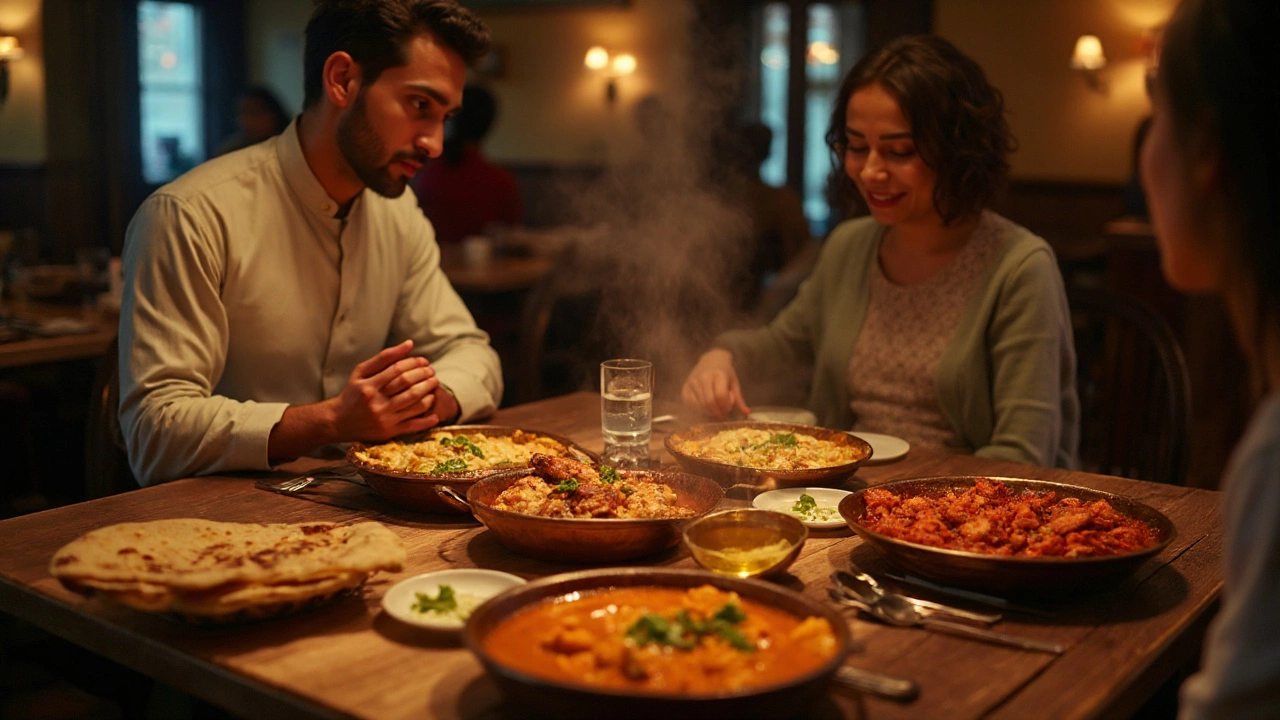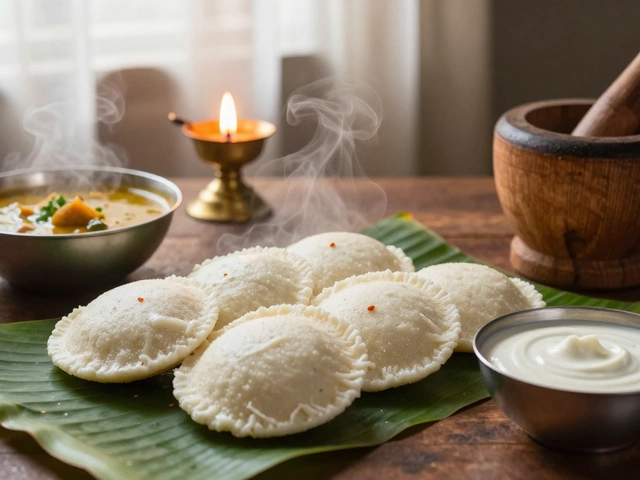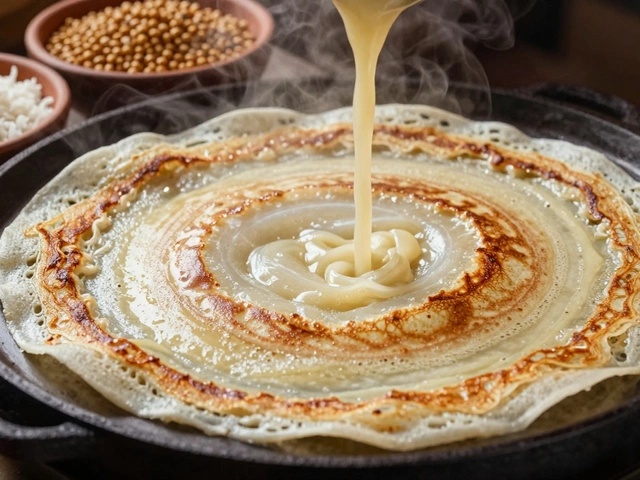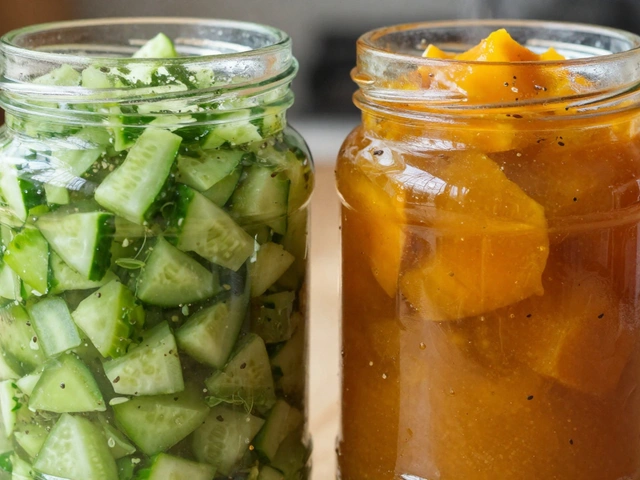You’ve stared at a menu, wondered if tikka masala is just “curry,” and felt unsure what to order. Here’s the simple truth: curry is a family; tikka masala is one specific member with a very particular personality. I’ll show you what makes it different, how to spot it at a glance, how it compares to other favourites, and how to cook a quick version at home without turning your kitchen into a spice fog.
- No-tikka masala is a specific curry: grilled marinated pieces (tikka) stirred into a tomato-forward, creamy, spiced sauce (masala).
- It sits in the British-Indian curry house tradition, likely born in the UK (often credited to Glasgow in the 1970s), not a classic dish from India’s home kitchens.
- Compared with other curries, it’s medium heat, tangy-sweet, rich but not as buttery as makhani; chunkier and brighter than korma; creamier than jalfrezi or madras.
- Fast cheat: char marinated chicken under a hot grill, build a tomato-onion sauce with garam masala, and finish with cream or coconut milk.
- Ordering tip: ask if the base is tomato-cream with grilled tikka pieces. If yes, you’ve got tikka masala; if it’s a buttery makhani or onion-heavy bhuna, it’s not.
What “curry” actually means-and where tikka masala sits
“Curry” isn’t one dish. It’s a catch-all word used in Britain and beyond for a huge range of South Asian dishes cooked in spiced sauces. In India, people usually name the exact dish or style-korma, rogan josh, saag, chettinad-rather than saying “curry.” So asking “Is tikka masala just curry?” is a bit like asking whether cappuccino is just coffee. Yes, it’s coffee, but it’s a very specific kind.
Break the name down and the picture sharpens. “Tikka” means bite-size pieces of meat or paneer, typically marinated in yogurt and spices, then charred in a super-hot tandoor or under a grill. “Masala” is a spiced mixture-in this case, a sauce built around tomatoes, onion, aromatics, and a warm garam masala blend, enriched with cream (or sometimes coconut milk). Put them together and you get grilled pieces simmered in a tangy, creamy, gently smoky sauce. That’s tikka masala.
Where did it come from? Food historians often credit British curry houses for shaping the dish we now recognize, with a popular story tying it to a Glaswegian restaurant in the 1970s that mellowed spicy, dry chicken tikka by adding a tomato-cream sauce. It’s debated, of course, but the British roots are widely acknowledged. Former UK Foreign Secretary Robin Cook even celebrated chicken tikka masala in a 2001 speech as a “true British national dish,” reflecting the country’s multicultural table. If you want to go deeper on the history, check works like The Oxford Companion to Food (Alan Davidson) and Lizzie Collingham’s Curry: A Tale of Cooks and Conquerors, which track the cross-cultural journey of these dishes.
So, is it “just curry”? It’s a curry, yes, in the broad sense. But it’s not any curry. It’s a particular style with telltale signs:
- Color and shine: sunset-orange to brick-red, glossy from cream or ghee.
- Texture: medium-thick, spoon-coating sauce; not watery; not a heavy paste.
- Aroma: warming spices (coriander, cumin, cardamom), gentle smoke from the tikka, and a tomato tang.
- Heat: usually mild to medium. You can ask for “madras hot,” but it’s not built to be a scorcher.
- Protein: often chicken, but paneer, lamb, or even jackfruit pop up in modern menus.
How is it different from just “a curry”? Technique. Tikka masala starts with marinated, high-heat-charred pieces, then a separate tomato-forward sauce. “Generic” curries in takeaway shorthand might be onion-heavy gravies (bhuna), coconut-based sauces (South Indian styles), yogurt-nut creamy kormas, or dry stir-fried jalfrezis. The base and process define the dish as much as the spices do.
Now, the common mix-up: tikka masala vs butter chicken (murgh makhani). Both are orange-ish, creamy, and beloved in the West. But butter chicken’s base sauce is silkier and more butter-forward, often strained for a smooth finish and slightly sweeter. Tikka masala usually has a chunkier, spicier onion-tomato base with a bit more tang and grill smokiness.
Here’s a quick side-by-side with other popular dishes so you can spot the differences at the table or on a menu:
| Dish | Base & Texture | Signature Notes | Typical Heat | Common Protein | Roots |
|---|---|---|---|---|---|
| Tikka Masala | Tomato-onion, cream-enriched; medium-thick | Grilled tikka pieces; tangy, warm spices | Mild-Medium | Chicken, Paneer | British-Indian curry house |
| Butter Chicken (Makhani) | Tomato-butter-cream; silky, often strained | Buttery, slightly sweet, subtle spice | Mild | Chicken | North India (Punjabi) |
| Korma | Onion-yogurt-nut; rich and pale | Sweet-savory, cardamom, less tomato | Mild | Chicken, Lamb | Mughlai/North India |
| Jalfrezi | Stir-fried peppers/onions; drier | Bright, peppery, less creamy | Medium-Hot | Chicken, Prawn | British-Indian |
| Madras | Tomato-onion; thinner, chili-forward | Hot, tangy, often fenugreek | Hot | Beef, Lamb, Chicken | South Indian-inspired (British naming) |
| Rogan Josh | Onion-tomato or yogurt; aromatic | Kashmiri chilies, cardamom | Medium | Lamb | Kashmir |
Rule of thumb: if the menu says “tikka” plus a cream-tomato sauce, it’s tikka masala; if it leans buttery-smooth with a milder spice snap, think makhani. If it’s pale and nutty, korma. If it’s peppery and stir-fried, jalfrezi. If it’s fiery red with a thinner sauce, likely madras.

How to tell-and order-like you’re confident
Menus can be vague. Here’s a simple decision path when you’re ordering:
- See “tikka” in the title? Ask: “Is that grilled and then served in a tomato-cream sauce?” If yes, that’s the classic tikka masala profile.
- If the server says it’s buttery and super smooth, less tang: that’s closer to butter chicken.
- If it’s pale with cashew or almond and little tomato: korma territory.
- If it’s stir-fried with peppers and onions, not very saucy: jalfrezi.
- If it’s bright red and chili-led with a thinner sauce: madras or vindaloo.
What about heat? Tikka masala is usually offered mild by default. If you want a kick without losing balance, ask for “one notch hotter” rather than “extra hot,” which can swamp the dish’s cream-tomato character. For dairy-free, ask if they can swap cream for coconut milk-most curry houses can, and it still tastes great.
Pairing cheat sheet:
- Naan vs rice: Naan if you want to scoop and mop; basmati if you’d rather keep it lighter. I often split one naan per two people and add a pilau rice to share.
- Sides that make sense: tangy cucumber raita (cooling), lime-pickled onions (zing), and a dry veg like aloo gobi to balance the rich sauce.
- Drink: a crisp lager, a light chilled red (Gamay/Pinot), or a dry cider cuts through the cream.
Red flags to avoid:
- Electric-red sauce that stains everything: often heavy food coloring. Natural tomato and chili give a warmer orange-red.
- Claggy, overly sweet sauce: too much sugar or ketchup; you want fresh tomato tang, not dessert.
- Boiled-tasting chicken: not “tikka.” You should see light charring or at least seared edges.
Short checklist you can keep in your head:
- Ask: “Tomato-cream base with grilled pieces, right?”
- Scan: orange-red, glossy, not neon.
- Smell: warm spices, a little smoke, tomato brightness.
- Taste: mild-medium heat, tang first, gentle sweetness after.
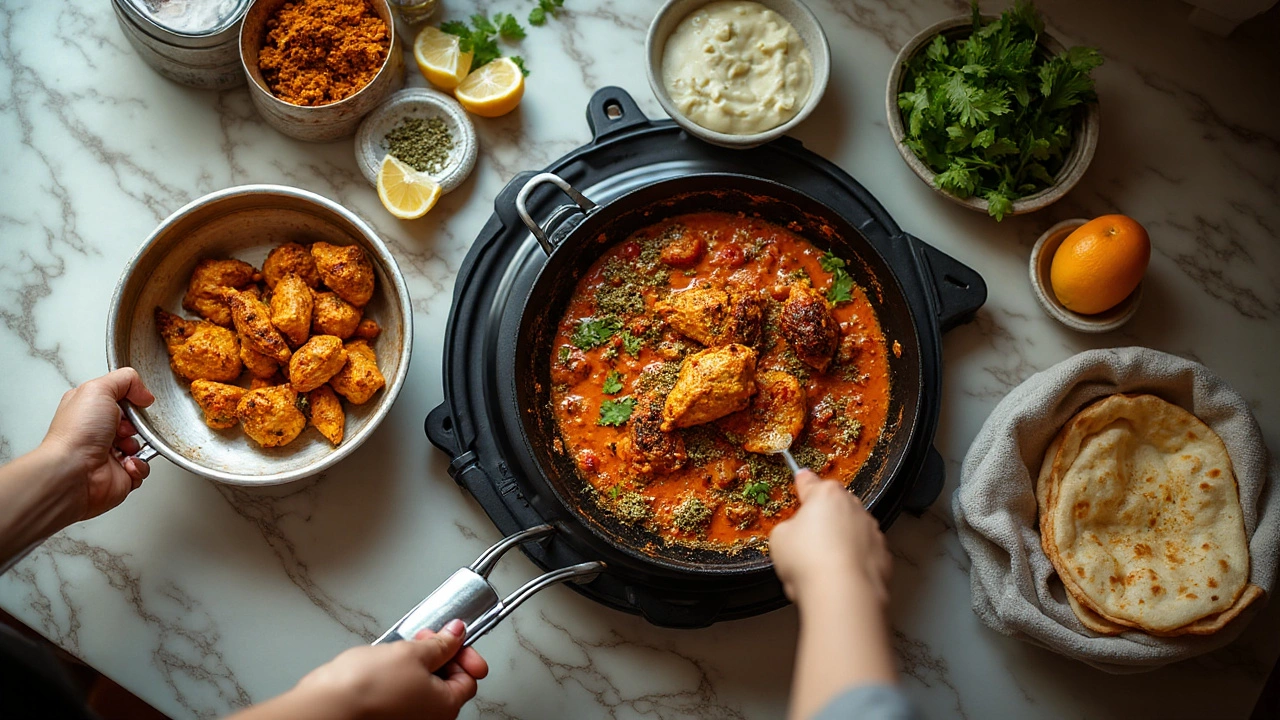
Cook a fast, weeknight tikka masala (plus smart swaps)
Yes, you can make a solid tikka masala in 30-40 minutes. Is it the slow-simmered weekend version? No. But it’ll satisfy and beat most jars. Here’s the flow that gets you there without fuss.
Serves 4. You’ll need two pans (or one pan and a grill) and a blender.
Ingredients:
- 600 g boneless chicken thighs, cut into 3 cm pieces (or 400 g paneer cubes)
- For the quick marinade: 120 g thick yogurt, 2 tsp grated ginger, 2 tsp grated garlic, 1 tsp ground cumin, 1 tsp ground coriander, 1 tsp paprika, 1/2 tsp turmeric, 1/2 tsp salt, 1 tbsp lemon juice
- For the sauce: 2 tbsp neutral oil or ghee, 1 large onion (finely chopped), 3 cloves garlic (minced), 1 tbsp grated ginger, 1-2 green chilies slit (optional), 1.5 tsp ground cumin, 1.5 tsp ground coriander, 1 tsp paprika, 1/2 tsp turmeric, 1/2 tsp Kashmiri chili (or mild chili powder), 1 tsp garam masala, 400 g canned crushed tomatoes, 100 ml water, 80-120 ml double cream (or coconut milk), 1 tsp sugar (only if tomatoes are very sharp), 1 tsp kasuri methi (dried fenugreek leaves), 1 tsp salt (to taste)
- Finish: fresh coriander, squeeze of lemon
Steps:
- Marinate fast: Toss chicken (or paneer) with the marinade. Even 10-15 minutes helps; the acid and spices wake it up quickly.
- Char the tikka: Heat your grill or a heavy pan until very hot. If grilling, thread the chicken on a tray and grill 6-8 minutes, turning once, until lightly charred and just cooked. If pan-searing, add a film of oil and sear in batches for deep browning. Set aside.
- Build the sauce: In a wide pan, warm oil/ghee. Cook onion with a pinch of salt 6-8 minutes until golden. Add garlic, ginger, and chilies; cook 1 minute. Add cumin, coriander, paprika, turmeric, and chili; stir 30 seconds to bloom.
- Tomatoes in: Pour in crushed tomatoes and water. Simmer 8-10 minutes, stirring now and then, until the raw tomato smell mellows and the sauce thickens.
- Blend for body: Either blend the sauce smooth in a jug blender and return it to the pan, or use a stick blender. Smoothness is up to you-tikka masala can be slightly rustic.
- Creamy finish: Stir in cream (start with 80 ml) and garam masala. Add sugar only if the tomatoes are too sharp. Crumble in kasuri methi by rubbing it between your fingers. Salt to taste.
- Marry the two: Add the grilled chicken/paneer and simmer 3-5 minutes so the charred edges flavor the sauce. Adjust thickness with a splash of water or cream.
- Serve: Top with coriander and a squeeze of lemon. Eat with warm naan or basmati rice.
Make it yours:
- Vegan: Use extra-firm tofu or roasted cauliflower; swap yogurt for coconut yogurt; use coconut milk or cashew cream.
- Lighter: Use evaporated milk instead of cream; or add 2 tbsp cashew butter for richness and thin with water.
- Spicier: Add 1/2 tsp hot chili powder when blooming spices; finish with a pinch more garam masala.
- Nutty: Blend 2 tbsp soaked cashews into the sauce for body.
- Time-saver: Use a good tikka paste for the marinade; skip chili if your paste is hot.
Quick fixes if something feels off:
- Too sour: 1 tsp sugar or honey, plus a splash more cream.
- Too sweet: Add lemon juice and a pinch of salt; simmer 2 minutes.
- Too thick: Thin with hot water or stock a little at a time.
- Too mild: Warm a pinch of chili powder in oil and stir in.
- Flat flavor: Another pinch of garam masala at the end wakes it up.
Storage and reheating:
- Fridge: 3 days, airtight. It tastes even better on day two.
- Freeze: Up to 2 months. Thaw in the fridge and reheat gently; add a splash of water or cream to loosen.
- Leftovers tip: Toss with cooked pasta for masala pasta, or spoon into a naan wrap with cucumber and herbs.
Example plating ideas:
- Weeknight: Half rice, half steamed greens, small ladle of masala-balanced and fast.
- Treat night: Garlic naan, onion salad, and a crisp lager.
- Family style: Big pot in the middle, mixed veg sides (saag, aloo gobi), and warm chapatis.
Mini-FAQ
- Is it British or Indian? The dish in its familiar curry house form is British-Indian. Its techniques and spices are rooted in North Indian cooking, but the tomato-cream style we love was shaped in the UK. Food histories like The Oxford Companion to Food and Collingham’s Curry back this blended origin story.
- Is curry a spice? No. Curry is a dish category. Curry powder is a British spice blend inspired by Indian masalas, not a traditional single spice.
- Can I make it without cream? Yes. Use coconut milk, evaporated milk, or cashew cream. It’ll still be rich and satisfying.
- Why is it orange-red? Tomatoes, paprika, and mild chilies-sometimes a bit of turmeric. It shouldn’t need artificial color.
- Is it the same as butter chicken? Close cousins. Butter chicken is silkier, sweeter, more butter-forward; tikka masala is tangier, spicier, and often chunkier.
- Do I need a tandoor? No. A ripping-hot oven grill, cast-iron pan, or air fryer can give you char and color.
- What’s the best garam masala? Freshly ground is king. If buying, choose blends listing whole spices like cardamom, cinnamon, cloves, pepper, and cumin-short ingredients, no fillers.
Next steps & troubleshooting by scenario
- Takeaway regular: Ask your local if they do a “less sweet, extra tangy” tikka masala. Many kitchens will tweak the balance if you’re specific.
- First-time cook: Start with thighs (forgives timing), canned tomatoes you trust, and a mild chili. Follow the steps as written before experimenting.
- Dairy-free eater: Coconut milk works; keep heat medium to avoid splitting. Finish with kasuri methi for that classic restaurant aroma.
- Spice-shy family: Skip the green chilies. Use paprika for color and Kashmiri chili in small amounts for gentle warmth.
- Meal prepper: Make double sauce and freeze flat in bags. Cook fresh tikka and finish in the reheated sauce for best texture.
- Low-sodium: Bloom whole spices (cumin seeds, bay leaf) in oil to build flavor without needing extra salt.
Handy rules of thumb:
- Ratio for fast sauce: 1 onion : 1 can (400 g) tomatoes : 80-120 ml cream.
- Spice baseline per 4 servings: 1.5 tsp cumin + 1.5 tsp coriander + 1 tsp paprika + 1/2 tsp turmeric + 1 tsp garam masala.
- Marinade balance: 2 parts yogurt : 1 part lemon juice by volume; salt the meat, too.
- Heat scaling: Add chili in oil, not at the end, for deeper, even heat.
Pitfalls to avoid:
- Rushing the onions: Pale onions equal flat sauce. Go for light golden before adding spices.
- Adding cream too early: It can split. Thicken your tomato base first, then stir in cream at the end.
- Overcrowding the pan while charring: You’ll steam the meat. Work in batches for color and flavor.
Examples to make it stick:
- Ordering at a British curry house: “Chicken tikka masala, please-tomato-cream base, right? Medium heat, not sweet.” You’ve just shown you know the dish.
- Cooking for friends: Make the base sauce an hour ahead. Char chicken right before serving and finish the dish in five minutes. Warm naan in the oven during that last simmer.
- Leftover magic: Shred leftover tikka masala chicken, toss with lime and herbs, stuff into a toasted wrap with shredded lettuce-a fast next-day lunch.
If you remember nothing else, remember this: “Curry” is the genre; tikka masala is the track you’re queuing. It’s defined by grilled, marinated pieces and a tomato-cream sauce with warm spices and a bright tang. Once you know those signals, you’ll spot it anywhere-and cook it any night you like.
